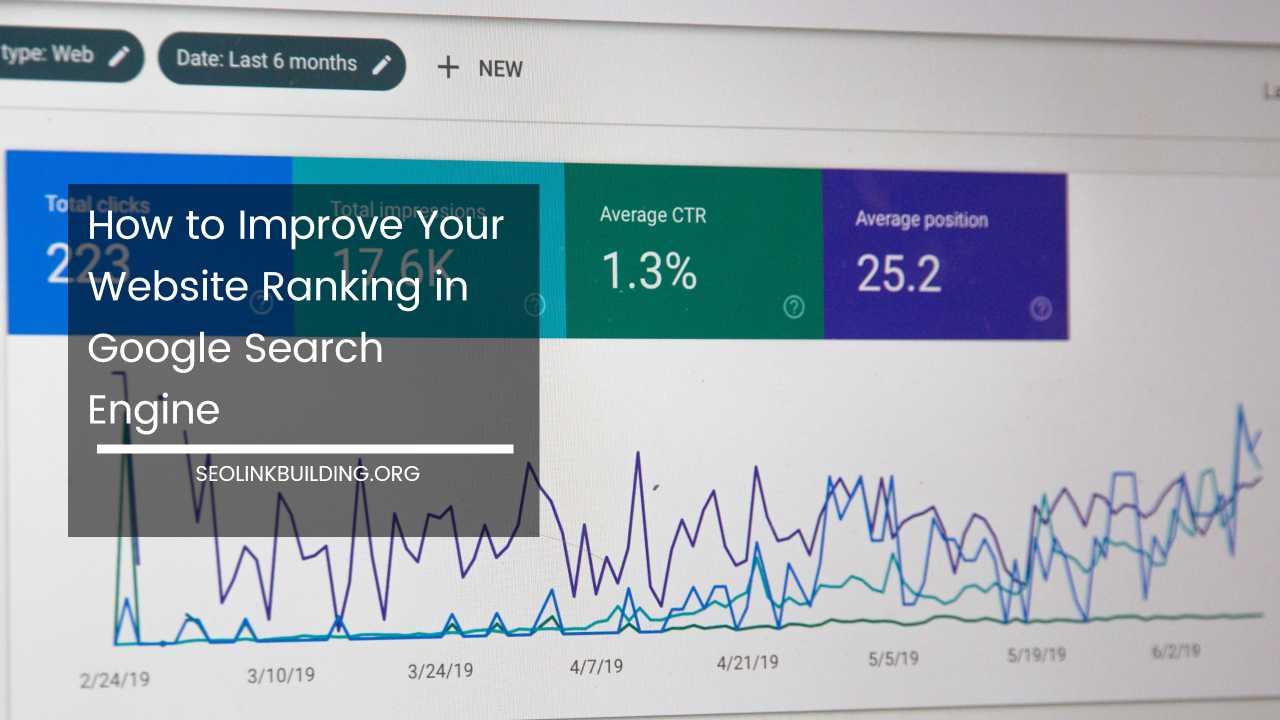How to Improve Your Website Ranking in Google Search Engine

How to Conquer the SERPs: A Comprehensive Guide to Boosting Your Website’s Ranking in Google Search Engine
In the ever-evolving digital landscape, achieving a prominent position in search engine results pages (SERPs) is no longer a luxury – it’s a necessity.
Google, the undisputed emperor of search engines, holds the key to unlocking vast troves of organic traffic for businesses and creators alike. But how do you convince this algorithmic mastermind to elevate your website to the top of its ever-shifting rankings?
Fear not, SEO aspirants! This comprehensive guide equips you with the knowledge and strategies to climb the Google rankings and reach your target audience.
We’ll delve into the intricacies of SEO, explore on-page and off-page optimization techniques, and unveil the secrets to crafting a user-centric website that Google and your audience will adore.
Demystifying the SEO Landscape
Search Engine Optimization (SEO) is the art and science of strategically aligning your website with Google’s ranking algorithms.
It’s a multifaceted endeavor encompassing everything from meticulously crafted content to ensuring the technical prowess of your website. Here’s a breakdown of the two main pillars of SEO:
-
On-page SEO: This focuses on optimizing the individual web pages of your website to resonate with search engine queries and provide an exceptional user experience.
-
Off-page SEO: This involves building your website’s authority and credibility by acquiring backlinks from high-quality websites in your niche. Think of it as building a strong reputation online.
On-page SEO: The Bedrock of Your Ranking Strategy
On-page SEO forms the foundation of your ranking efforts. Here’s a detailed exploration of how to optimize your website’s content and structure for Google’s favor:
- Keyword Research: Unearthing the Golden Nuggets
The first step is to identify the keywords and phrases your target audience uses to search for information related to your niche.
These are your golden nuggets, the keys to unlocking organic traffic. Keyword research tools like Google Keyword Planner and SEMrush can be invaluable in this process.
But don’t just stop at high search volume – delve deeper. Consider factors like keyword difficulty (how competitive it is to rank for that keyword) and search intent (what the user is hoping to achieve with their search).
By targeting a mix of high-intent, medium-volume keywords and long-tail keywords (more specific, multi-word phrases), you can attract qualified leads while avoiding overly competitive search terms.
- Content is King (and Queen): Craft Content that Captivates
Content is the lifeblood of any website, and high-quality, informative content that caters to your audience’s search intent reigns supreme.
-
Informative Blog Posts: Establish yourself as a thought leader in your niche by crafting in-depth blog posts that address your audience’s pain points, answer their questions, and offer valuable insights.
-
Compelling Product Descriptions: Don’t just list features – tell a story. Compelling product descriptions should highlight the benefits your product offers, showcase its unique selling points, and use relevant keywords to ensure searchability.
-
Engaging Guides and Tutorials: Provide step-by-step guides, informative tutorials, or downloadable resources that empower your audience and establish your expertise.
Remember, prioritize user-friendliness. Break down complex topics into bite-sized pieces, utilize clear headings and subheadings, and leverage bullet points and numbered lists for easy scannability.
- Embrace the Power of Keywords (Strategically)
While incorporating your target keywords throughout your content is crucial, prioritize readability above all else.
Keyword stuffing is a surefire way to get penalized by Google. Instead, integrate keywords naturally within your content, focusing on providing value to the user.
- Meta Descriptions and Titles: Crafting Compelling Clickbait
Meta descriptions and page titles are like captivating movie trailers for your content. They entice users and accurately reflect the value your content offers.
Titles should be concise, informative, and keyword-rich, typically under 60 characters. Meta descriptions, ideally around 155 characters, serve as clickbait – convincing users your page holds the answer to their search query.
- Internal Linking: Building a Cohesive Website
Imagine your website as a meticulously woven spiderweb. Internal linking helps users and search engines navigate your content by connecting relevant pages.
It improves user experience by allowing users to delve deeper into related topics and informs Google about your website’s structure and hierarchy. Strategically link to high-quality, authoritative pages on your website to distribute link equity and enhance the overall SEO power of your website.
Technical SEO: The Unsung Hero Behind the Scenes
While on-page SEO polishes the outward appearance of your website, technical SEO ensures its smooth operation behind the scenes. Here are some key technical considerations to keep in mind:
- Mobile-friendliness: A Non-Negotiable
In our mobile-first world, a website that doesn’t render flawlessly on smartphones and tablets is doomed to ranking oblivion.
Google prioritizes mobile-friendly websites in search results, so ensuring a seamless mobile experience is paramount. Utilize responsive design, a technology that allows your website to adapt automatically to different screen sizes.
- Website Speed: A Race Against the Clock
A slow website frustrates users and gets penalized by Google. Prioritize optimizing page load speed. Here are some tactics to consider:
Image Compression: Large images can significantly slow down your website. Utilize image compression tools to reduce file sizes without compromising quality.
Caching Mechanisms: Caching stores frequently accessed website elements, allowing them to load faster for returning visitors.
Clean Codebase: A bloated codebase with unnecessary elements can hinder website speed. Streamline your code for optimal performance.
- Structured Data Markup: Providing Context to Search Engines
Think of structured data markup as helpful labels for your content. By implementing schema markup, you provide search engines with richer information about your website, potentially enhancing your search result snippets.
This can include details like your business address, opening hours for a local store, product ratings and reviews for an e-commerce website, or even information about upcoming events.
Off-page SEO: Building Authority and Establishing Trust
While on-page SEO optimizes the internal aspects of your website, off-page SEO focuses on building its reputation in the vast digital landscape. Here’s how to establish your website as a trustworthy source and earn Google’s favor:
- Backlink Building: The Currency of Authority
Earning backlinks (links from other websites pointing to yours) is the cornerstone of off-page SEO. Backlinks act as votes of confidence, signaling to Google that your website is valuable, credible, and relevant.
-
Guest Blogging: Contribute high-quality guest posts to reputable websites in your niche. This allows you to showcase your expertise, reach a wider audience, and earn a valuable backlink to your website.
-
Broken Link Building: Identify broken links on relevant websites and reach out to the website owners, suggesting your content as a replacement. This is a win-win situation – you get a valuable backlink, and they fix a broken link on their website.
-
Social Media Promotion: Don’t just create fantastic content – actively promote it! Share your content on social media platforms like Twitter, Facebook, and LinkedIn to generate buzz and potentially attract backlinks from others who share your content.
-
Online Reputation Management: Actively manage your online reputation by addressing negative feedback promptly and professionally. Positive reviews and customer testimonials can also boost your website’s credibility. Encourage satisfied customers to leave reviews on Google My Business or other relevant platforms.
Content is King, But User Experience is Queen: Prioritizing User-Centric Design
Remember, SEO isn’t just about ranking high – it’s about creating a website that users love. Here are some user-centric considerations to keep in mind:
- Website Navigation: A Clear Path to Information
Ensure your website has a clear and intuitive navigation structure. Users should be able to find the information they need effortlessly, regardless of their entry point. Utilize clear menus, well-defined categories, and a sitemap for a seamless user experience.
- Engaging Visuals: Breaking Up Text and Captivating Attention
High-quality images, infographics, and videos can significantly enhance user engagement and break up text-heavy content. Utilize relevant visuals that complement your content and grab the user’s attention.
- Mobile Optimization: A Must-Have, Not a Luxury
As mentioned earlier, prioritize a seamless mobile experience. Responsive design ensures your website adapts flawlessly to different screen sizes, offering an optimal user experience for mobile users.
Measure, Analyze, and Adapt: SEO is a Continuous Journey
SEO is an ongoing process, not a one-time fix. Here’s how to stay ahead of the curve:
-
Website Analytics Tools: Utilize website analytics tools like Google Search Console to track your website’s traffic, identify your top-performing pages, and monitor your keyword rankings. This data is invaluable for understanding user behavior and refining your SEO strategy.
-
Stay Updated on Google Algorithm Changes: Google’s algorithm is constantly evolving. Stay informed about the latest updates by following SEO industry publications and blogs.
-
Experiment and Refine: SEO is an iterative process. Don’t be afraid to experiment with different strategies and content formats. Track the results of your efforts and continuously refine your approach based on data and user feedback.
Final Thoughts: The Road to SEO Success
By implementing the strategies outlined in this comprehensive guide, you will be well-equipped to embark on your SEO journey. Remember, SEO is a marathon, not a sprint.
Consistency, patience, and a commitment to creating high-quality content that resonates with your target audience are key ingredients for achieving lasting SEO success. Here are some additional tips to keep in mind:
-
Local SEO for Brick-and-Mortar Businesses: If you have a physical location, optimize your website for local searches. Claim your Google My Business listing, ensure your NAP (Name, Address, Phone number) is consistent across the web, and encourage customers to leave positive reviews.
-
E-commerce SEO: Optimizing for Product Discovery: For e-commerce websites, prioritize product page optimization. Utilize high-quality product images, detailed descriptions with relevant keywords, and clear calls to action.
-
Voice Search Optimization: The Rise of Conversational Search: With the growing popularity of voice search assistants like Siri and Alexa, consider optimizing your content for conversational queries. Focus on long-tail keywords and natural language phrasing that people might use when speaking their search queries.
-
Building a Backlink Profile: Quality Over Quantity: While backlinks are crucial, prioritize quality over quantity. Earning backlinks from high-authority websites in your niche holds more weight than acquiring links from low-quality websites.
-
Embrace White Hat SEO Techniques: Avoid black hat SEO tactics like keyword stuffing or link buying. These practices can get your website penalized by Google and ultimately harm your ranking efforts.
The SEO Journey Begins Now
The ever-evolving landscape of SEO can seem daunting, but with the knowledge and strategies outlined in this guide, you’re well on your way to conquering the SERPs.
Remember, SEO is a continuous process of learning, adapting, and refining your approach. Stay curious, experiment strategically, and prioritize creating a user-centric website that offers genuine value to your audience.
By doing so, you’ll not only climb the Google rankings but also establish yourself as a trusted authority in your niche, attracting organic traffic and achieving long-term success.













